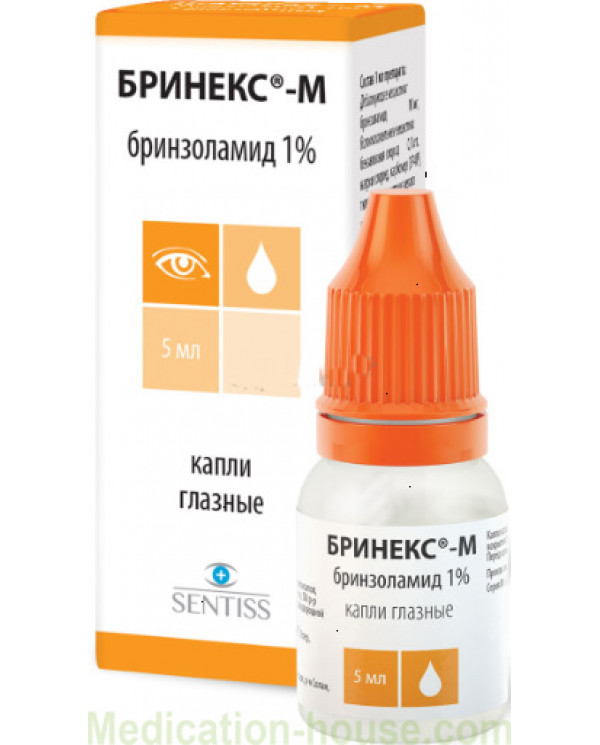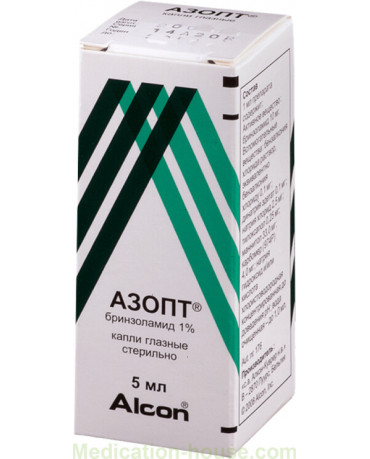Brinex-M instruction
You can buy Brinex-M here
Indications for use
To reduce increased intraocular pressure in ophthalmic hypertension and open-angle glaucoma:
- as monotherapy in adult patients who do not respond to beta-blockers;
- in adult patients for whom beta-blockers are contraindicated;
- as an additional therapy to beta-blockers or prostaglandin analogs.
Active ingredient, group
Brinzolamide, antiglaucoma agent, carbonic anhydrase inhibitor
Contraindications
- severe renal failure;
- hyperchloremic acidosis;
- known hypersensitivity to sulfonamides;
- hypersensitivity to the active substance or to any of the excipients.
How to use: dosage and course of treatment
The drug is used topically. After instillation, it is recommended to perform a nasolacrimal occlusion or carefully close the eyelids. This can reduce the entry of the drug into the systemic circulation and thereby reduce the development of systemic side effects.
When using the drug Brinex-M as monotherapy or in combination with other drugs, it is recommended to instill 1 drop into the conjunctival sac of the affected eye (affected eyes) 2 times / day. Some patients may respond better to treatment with 1 drop 3 times / day.
Pharmachologic effect
Inhibition of carbonic anhydrase at the level of the ciliary body reduces the secretion of aqueous humor by slowing down the formation of bicarbonate ions with a subsequent decrease in sodium and water transport, which leads to a decrease in intraocular pressure. Increased intraocular pressure is a major risk factor for damage to the optic nerve and narrowing of the visual field.
Side effects of Brinex-M
From the hematopoietic system: infrequently - a decrease in the number of erythrocytes.
From the immune system: frequency unknown - hypersensitivity.
Mental disorders: infrequently - apathy, depression, depressed mood, decreased libido, nightmares, nervousness; rarely - insomnia.
From the nervous system: infrequently - motor dysfunction, amnesia, dizziness, paresthesia, headache; rarely - memory impairment, drowsiness; frequency is unknown - tremor, hypesthesia, ageusia.
From the side of the organ of vision: often - blurred vision, eye irritation, pain in the eyes, sensation of a foreign body in the eyes, ocular hyperemia; infrequently - corneal erosion, keratitis, punctate keratitis, keratopathy, accumulation in the eyes, staining of the cornea, defect of the corneal epithelium, violations of the integrity of the corneal epithelium, blepharitis, itching of the eyes, conjunctivitis, conjunctival edema, rheumitis, photophobia, allergic conjunctiva, conducting diagnostic tests to confirm the violation of the integrity of the corneal epithelium, pterygium, scleral pigmentation, asthenopia, discomfort in the eyes, unusual sensation in the eyes, dry eye syndrome, subconjunctival cysts, conjunctival injection, itching of the eyelids, discharge from the eyes, crust on the edges of the eyelids, lacrimation, sensation of a foreign body in the eyes; rarely - corneal edema, diplopia, decreased visual acuity, photopsia, hypesthesia, edema of the periorbital region, increased intraocular pressure, change in the ratio of excavation diameters to the diameter of the optic nerve head; the frequency is unknown - disorders of the cornea, visual impairment, allergic manifestations of the eyes, madarosis, disorders of the eyelids, erythema of the eyelids.
From the organ of hearing and labyrinth: rarely - ringing in the ears; frequency unknown - dizziness.
From the side of the cardiovascular system: infrequently - cardiorespiratory distress syndrome, bradycardia, palpitations; rarely - angina pectoris, heart rhythm disturbances; the frequency is unknown - arrhythmia, tachycardia, hypertension, increased blood pressure, decreased blood pressure, increased heart rate.
From the respiratory system: infrequently - nasopharyngitis, pharyngitis, sinusitis, shortness of breath, nosebleeds, pain in the mouth, pain in the pharynx and larynx, irritation in the throat, inflammation of the upper respiratory tract, runny nose, sneezing; rarely - bronchial hyperactivity, a feeling of congestion in the upper respiratory tract, swelling of the mucous membrane of the paranasal sinuses, nasal congestion, cough, dry nose; frequency unknown - rhinitis, bronchial asthma.
From the digestive system: often - dysgeusia; infrequently - esophagitis, diarrhea, nausea, vomiting, dyspepsia, pain in the upper abdomen, abdominal discomfort, stomach discomfort, flatulence, frequent bowel movements, gastrointestinal disturbances, decreased sensitivity in the mouth, paresthesia in the mouth, dryness in mouth; the frequency is unknown - decreased appetite, changes in the results of the analysis of the functional state of the liver.
From the urinary system: infrequently - pain in the kidney area; frequency unknown - pollakiuria.
From the reproductive system: infrequently - erectile dysfunction.
On the part of the skin and subcutaneous tissues: infrequently - rash, maculo-papular rash, feeling of tightness of the skin; rarely - urticaria, hair loss, generalized itching; frequency unknown - dermatitis, erythema.
From the musculoskeletal system: infrequently - back pain, muscle spasms, myalgia; frequency unknown - arthralgia, pain in the limbs.
Others: infrequently - pain, chest discomfort, increased fatigue, unusual sensations, increased plasma chlorine; rarely - chest pain, anxiety, asthenia, irritability; frequency unknown - peripheral edema, malaise.
Special instructions for Brinex-M
Temporary blurred vision or other visual impairments can affect your ability to drive. If blurred vision is noted after instillation, the patient should wait until vision is restored before driving or working with equipment.
When switching from therapy with another ophthalmic antiglaucoma drug to brinzolamide treatment, the use of Brinex-M begins the next day.
If more than one topical drug is used, the drugs should be instilled at intervals of at least 5 minutes, eye ointments should be used last.
If one dose of the drug is missed, treatment is continued with the next dose. The dose should not exceed 1 drop in the affected eye (affected eyes) 3 times / day.
Before using the drug, the bottle should be shaken well. To prevent contamination of the dropper tip and suspension, avoid contact with the eye and other surfaces. The bottle should be kept tightly closed.
Application during pregnancy and lactation
Fertility
Based on the results of animal studies, no information was obtained on the effect of Brinex-M on fertility. There have been no studies evaluating the effect of brinzolamide solution for topical ophthalmic use on fertility in humans.
Pregnancy
There is no reliable data on the use of Brinex-M in pregnant women. In animal studies, data on reproductive toxicity have been obtained after systemic use. Brinex-M is not recommended for use during pregnancy and women of childbearing age who are not using contraception.
Breastfeeding period
It is not known whether brinzolamide / its metabolites are excreted in breast milk after instillation into the conjunctival cavity. Animal studies have demonstrated the excretion of minimal levels of brinzolamide into breast milk after oral administration.
In connection with the possibility of side effects in the infant during the treatment of the mother with Brinex-M drops, 10 mg / ml, a decision should be made to stop breastfeeding or to discontinue treatment, taking into account the importance of treatment for the mother and the importance of breastfeeding for the baby ...
Interaction
The isoenzymes of cytochrome P450, which are responsible for the metabolism of brinzolamide, include CYP3A4 (mainly), CYP2A6, CYP2C8, and CYP2C9. CYP3A4 inhibitors such as ketoconazole, itraconazole, clotrimazole, ritonavir and troleandomycin are expected to inhibit the metabolism of brinzolamide by CYP3A4. It is recommended to be careful with the concomitant use of CYP3A4 inhibitors.
Storage conditions
Store Brinex-M at temperatures from 4 to 30 C in original packaging.
Keep out of the reach of children!
Shelf life is 2 years.
After opening the bottle should be used within 42 days.
Do not use after the expiration date!
Terms of sell
You don't need a prescription to buy Brinex-M.


